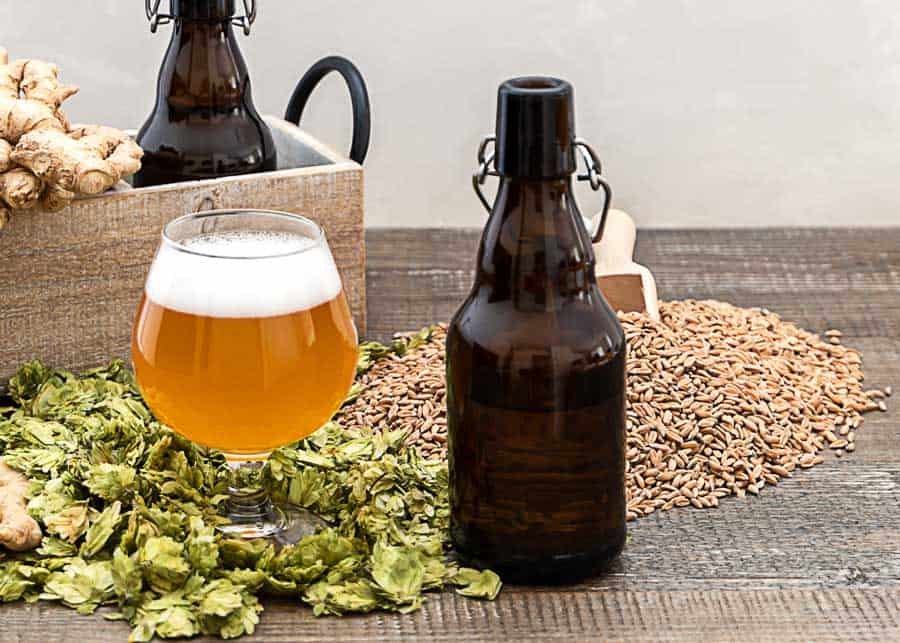Do you have a favorite draft beer? Maybe it is only sold at a brewery hours away. You may love it, but not enough to drive hours out of your way. What if you could take extra beer home and avoid the drive?
Crowlers and growlers both allow you to transport beer from a brewery back to your home. Crowlers are large aluminum cans that are filled and pressed while you wait. Growlers are glass jugs with resealable caps that hold 64 to 128 ounces of beer.
What’s the difference between crowler vs growler? There are several key differences between crowlers and growlers, including their history, size, materials, cost, and quality. Here’s the full breakdown.

What is a Crowler?
A crowler is a medium-sized aluminum can used to transport beer.
In 2002, Oskar Blues became the first craft brewery in the United States to use crowlers. Oskar Blues and the Ball Corporation teamed up to find a way to package beer behind the bar, allowing customers to take beer home easily.
At first, most other breweries did not believe crowlers would be popular. However, more than 600 breweries in the United States have begun offering these aluminum cans since then.
What is a Growler?
A growler is a large, glass container used to transport beer.
Growlers have existed in multiple forms since the 1800s.
- In the 1920s, the prohibition movement made it nearly impossible to sell or use growlers.
- Prohibition was repealed in 1933, allowing customers and breweries access to growlers again.
- In the late 1980s, Charlie Otto and his father were the first to use growlers to offer take-out beer.
Today, newer technology allows growlers to keep beer fresher than ever before.
Size: Crowler vs Growler
Generally, growlers hold more beer than crowlers and have more size options.
- Crowlers: Most crowlers hold 32 fluid ounces of beer.
- Growlers: The most common size for growlers is 64 fluid ounces. However, you may find growlers that hold 32 fluid ounces, 128 fluid ounces, 1 liter, or 2 liters.
Here’s how many beers a growler and crowler can hold.
Materials: Crowler vs Growler
One major difference between crowlers and growlers is the materials with which they are made.
Crowler Material
Crowlers are solid aluminum cans designed to reflect UV rays and sunlight. They are lightweight and durable.
A machine seals crawlers, providing an air-tight seal that keeps beer fresh.
Growler Material
Growlers are usually made of glass. Most have glass handles, but some have metal handles or no handles at all.
Growlers may have screw-tops or flip-tops. Screw-top caps are usually plastic, while flip caps consist of a rubber gasket, a metal hinge, and a plastic cap.
Unfortunately, neither creates the same air-tight seal that a crowler provides. Thus, many customers complain that their beer goes flat relatively quickly.
You may find amber-colored or clear growlers, otherwise known as flint growlers.
Some growlers are ceramic, but most of these are for decoration.
Stainless steel growlers are uncommon but more durable than their glass counterparts. Stainless steel growlers can also be pressurized, allowing them to keep beer fresh for longer.
Cost: Crowler vs Growler
Crowlers are typically less expensive than growlers. The aluminum container costs less to produce than the glass growler, and crowlers are usually smaller.
Crowlers
You can expect to spend only $9 to $12 on a crowler. The exact price will depend on the brewery and the type of beer inside.
As a general rule, crowlers cost about $1 to $2 plus the price of the beer.
Growlers
Although growlers are initially more expensive, they can save you money down the road. You can clean your growler between fill-ups and reuse it as often as you like.
An empty growler can cost as little as $6 or more than $10, and you will spend $5 to $30 on a refill. In the end, you will likely spend between $20 and $30 on a new growler full of beer.
At some establishments, you can put a deposit down on a growler. After taking your beer home and emptying the growler, you can return the container to the seller. They will then refund you the money you spent on the growler.
Quality: Crowler vs Growler
Usually, crawlers are more reliable and effective than growlers.
Crowlers
Crowlers are very durable, perfect for those who have long commutes home. For example, it is much safer to bring an aluminum crowler on the subway than a glass growler.
Additionally, crowlers allow the beer to remain fresh and properly carbonated. Aluminum protects your beer from environmental elements that may taint its flavors, such as UV rays and sunlight.
The air-tight seal can keep your beer fresh for two weeks or more.
Growlers
Unfortunately, growlers are subject to issues with flavor, carbonation, and durability.
Glass growlers can shatter, which can be difficult for people in a rush to get home or who use public transportation.
The glass containers also allow sunlight to reach your beer, which can gradually change the flavor. If you have traveled for hours to get this perfect beer, you do not want to risk having a tainted flavor at home.
Although the seals on growlers are tight, they are not tight enough to trap the carbonation effectively over time. Without an air-tight seal, oxygen gradually reaches the beer and feeds the fermentation.
Most breweries recommend drinking your beer within three to five days when you use a growler.

Conclusion
Crowlers correct many of the design flaws in growlers. They are less likely to break, have lighter weight, and maintain the integrity of the beer more effectively.
Growlers have a rich history, and they are more attractive than crowlers. They also allow customers to carry more beer in one container, and they can be reused. Over time, they are less expensive than crowlers.
Luckily, many breweries offer both crowlers and growlers, so you can choose which is best for you.
